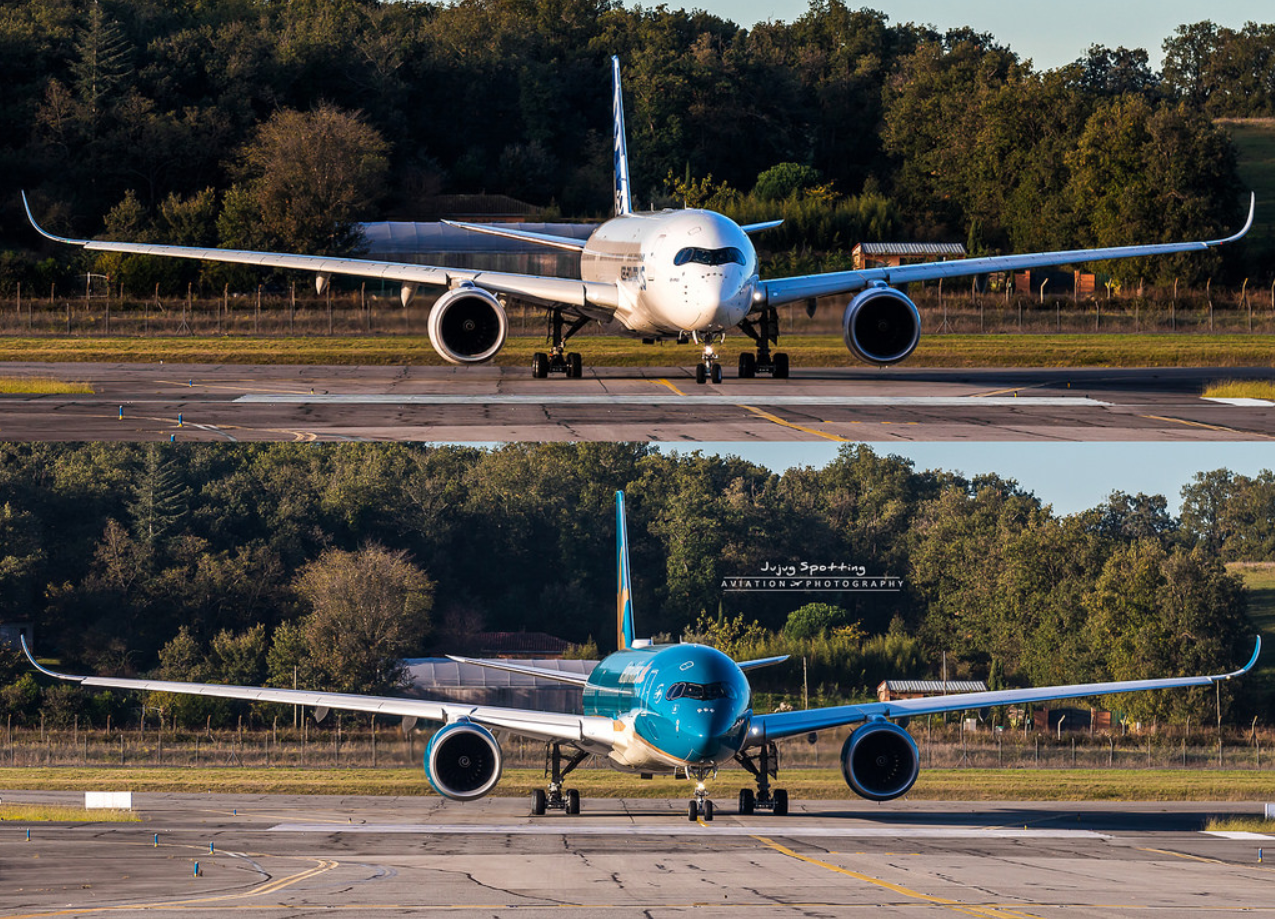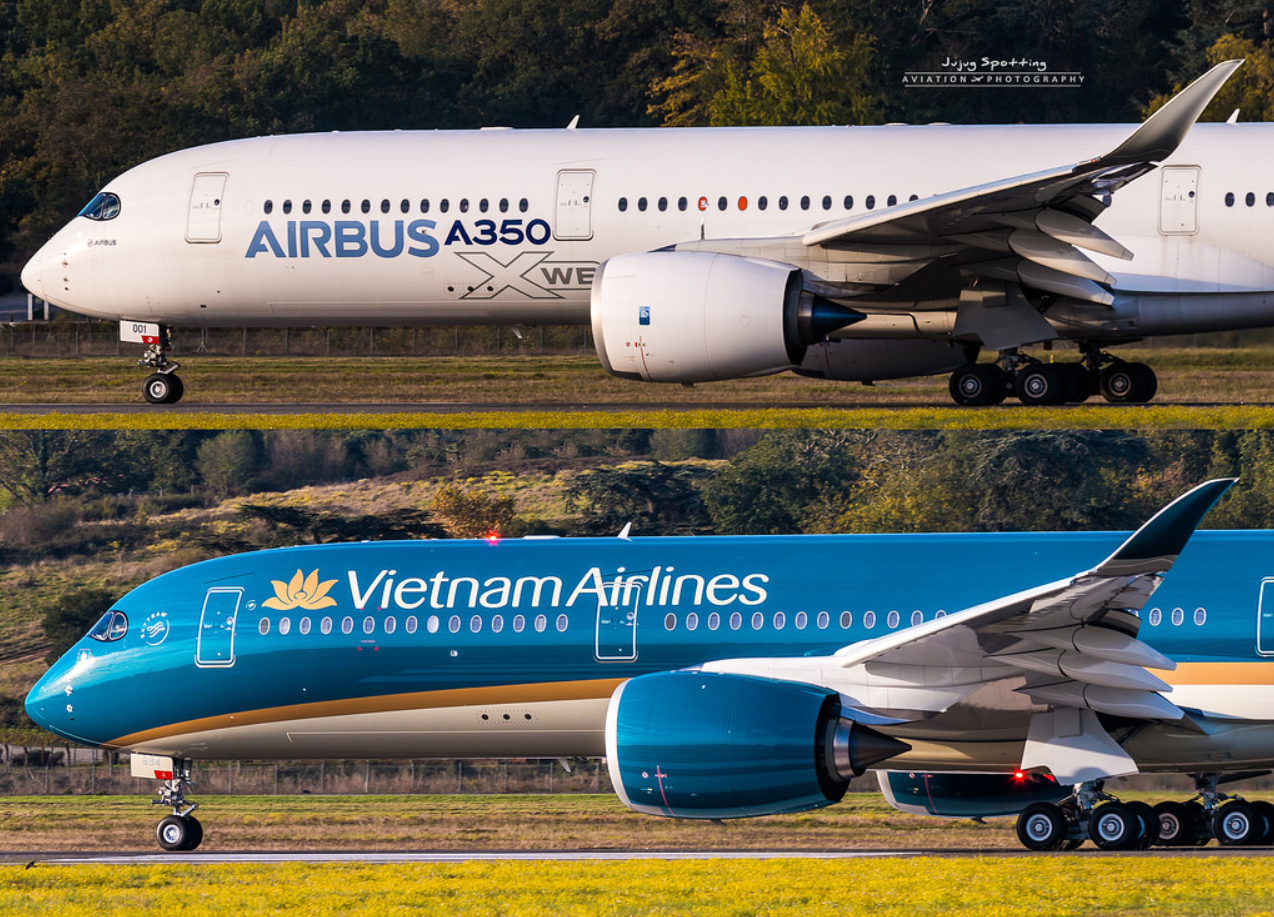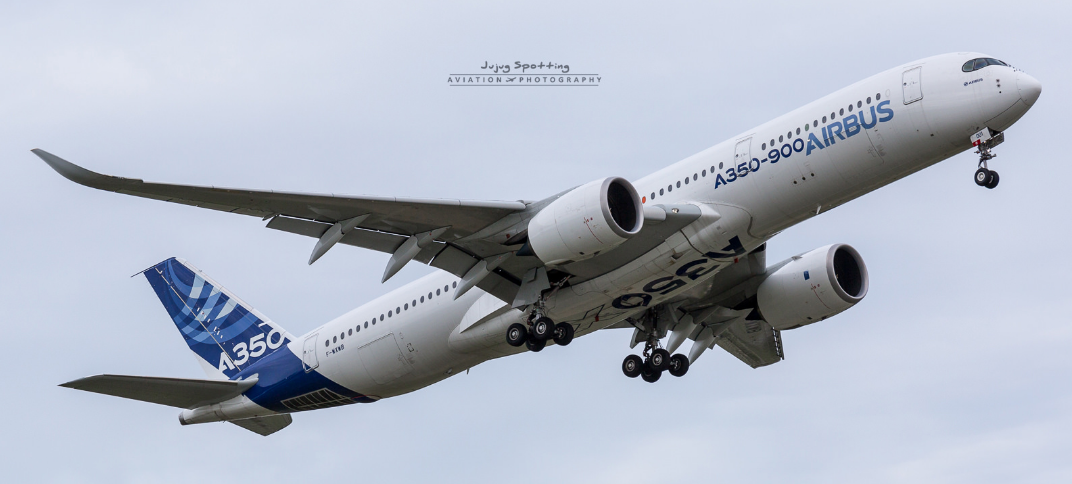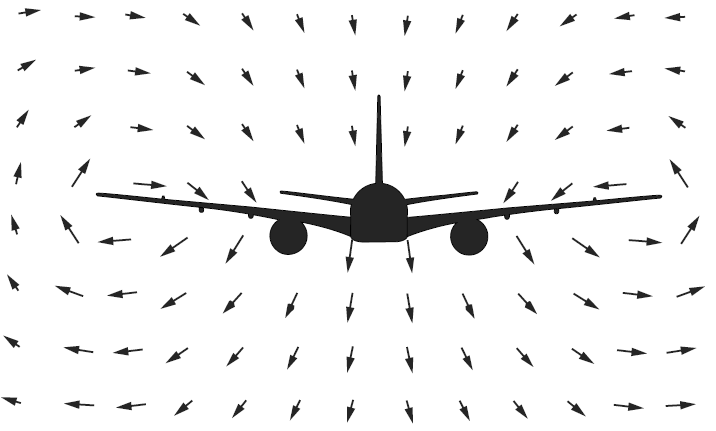Leeham News and Analysis
There's more to real news than a news release.
New pictures of the changed Sharklets for A350
By Bjorn Fehrm
November 01, 2017, © Leeham Co: We exclusively revealed last week that Airbus is working on new winglets for the A350 series. The new Sharklets were caught during flight-testing on Airbus A350 test aircraft, MSN001.
Jujug Spotting in Toulouse has provided us with new, better photos of the tests. With these, one can better estimate the changes and their effect.
New A350 Sharklets
The new photos show the original Sharklet A350-900 (performing Vietnam Airlines delivery tests) and the new Sharklet equipped MSN001. They are shot from the same angles (Figure 2 and 3).
By it, it’s possible to draw conclusions about the changed dimensions and shape. We have also got new information about their introduction.

Figure 2. A350-900 with new Sharklet (top) and with present Sharklet (bottom). Source: Jujug Spotting.
Figure 2 clearly shows the extra height of the changed Sharklets. The new variants are also squarer in their curvature than the original design.
Figure 3 makes it possible to see the difference in shape between the original and the new winglet.

Figure 3. A350-900 side view with new Sharklet (top) and the present model (bottom). Source: Jujug Spotting.
The original and new winglets don’t have the same form. The reason is, the wings are not the same. To understand why, we need to understand how winglets work.
Wings and winglets
Wing extensions, like Sharklets, use the winglet device to change the spanwise pressure distribution of the wing. It’s the cooperation of the winglet and the wing that gives the air the impression the wing has a longer span than the physical span. The new span created with the wingtip extension is called the effective wingspan.
There is a widespread misunderstanding that winglets are designed to change the way the wingtip vortices are flowing. This is mixing cause and effect. The winglet and wing changes the complete flow around and behind the wing. This total change of the flow pattern is what reduces the drag, not any local change in the vortices around the wingtips.
To understand this, we need to understand how a wing generates lift. The wing generates lift by forcing the air that it passes through to accelerate downwards. As the air accelerates downwards, the well-known Force = Mass * Acceleration (Newton’s second law) is at play. The weight of the air being accelerated down creates the lift force.
An alternative way to understand the lift force is by summing the difference in pressure on the wing’s upper and lower surfaces. This is the same physics at work. The acceleration of the air molecules downwards close to the wing on the upper surface, causes a thinning of the air, which creates the low pressure.
The opposite happens on the wing’s lower surface. The acceleration pushes the molecules closer together, increasing the pressure.
The difference in pressure makes the air molecules wanting to slink around the wingtip, causing the air sheet traveling downward to roll up around the wingtips, Figure 4. The energy consumed by this circular movement is the induced drag.
The energy consumption is not limited to the rotation around the wingtips. The rotation is along the whole span of the wing. Changing the flow around 10%-15% of the outer span does not stop the global rotation we see in Figure 4. In fact, it could increase the disorder of the air, causing more energy loss, that is higher drag.
Ludwig Prandtl (1895-1953, a great German aerodynamicists) showed the minimum induced drag for a flat rectangular wing would be when the spanwise pressure distribution (called the spanload distribution) would have an elliptical shape. With more advanced wing forms, including winglets, the shape is modified but it’s still close to an elliptical shape, Figure 5.

Figure 5. Ideal spanloads for a rectangular planar wing and a wing with a winglet. Source: “Wingtip devices“ by Doug McLean, Boeing
From Figure 5 we understand what we need to do for a lower induced drag for the A350-900. We need to change the complete spanwise pressure distribution of the wing, to a wider one. This will slow down the circular motion of the air around the wing.
This means the new Sharklet is designed together with changes to the wing, to get a new, wider spanload with a form which gives lowest total drag.
Airbus’ changed A350 wing and Sharklet
This is also what Airbus does. From the flight tests of the A350-900, Airbus knew there was potential to improve the spanload distribution for the wing. Such changes are normally done with adaptation of the spanwise twist of the wing. It was done this way for the A380.
For the A350, Airbus decided to combine a change of the wing twist with a taller, different shape winglet, to get an even wider and more optimal spanload distribution. The new wing and Sharklet shall be ready for the rollout of the first Singapore Airlines A350-900URL next year, giving this aircraft its longer legs. It will then find its way to the standard A350-900 and -1000.




Thanks Bjorn. Small point of clarification: If the winglet’s impact on pressure distribution should be combined with a change to wing twist, then why would retro-fitted winglets (presumably lacking a wing retwist) contribute significant L/D delta?
I’m guessing that the answer is that winglet+retwist is optimal to maintain something like an eliptical lift distribution, but that the gains from marginal span increase exceed the losses from sub-optimal lift distribution (in the case of retrofitted winglets). Is that right?
Hi Eric,
yes that’s right. With a well-designed retrofit winglet, it would be specifically made to try and keep a good spanload distribution, even after retrofit. So a custom-made wing change + winglet is best. A retrofit, if well made, is second best, but still worth doing if you fly longer routes.
Sort of like the later retrofitted B757 winglets, no?
Thanks Bjorn, nice to read about things that I don’t know much about. Could results of these tests have spin-offs for mods to the 330NEO wing?
Are their any merit/upside potential looking at wing tip mods of horizontal stabilizers in general?
If Airbus have done their homework the A330neo wing should be fine out the chute with its large wingtip extension. You can be sure the wing twist has been adapted as there is now a very different global spanload distribution between A330ceo and neo.
Thanks Bjorn. AB is obviously very busy with wing designs, this, laminar flow, etc.
With the RR Advantage and Ultrafan’s being developed things could become interesting in a few years at AB.
There’s no way A350 MSN1 has had new retwisted wings put on; it’s a jig twist before assembly.
I agree. The twist will come on the Singapore Airlines ULR wings. Now Airbus recalculates the pressure distribution IMO.
It’s for the new A350 ULR aircraft
The question comes up why they didn’t do it earlier, say before first delivery. Extensive wingtip testing / CFD was going on in the 8-9 years ago. A wing twist change. that isn’t a minor modification. What let to the new insights?
That is a burning questions. Competition with the 787’s and 777X’es a decision was most likely made as the 350 is still in a development ramp-up phase?
Airbus saw during flight test there was a chance to improve the spanload distribution even more. You then introduce it at a convenient production break. In this case, there was also stress margin left in the wing so a larger makeover, wing+tip, was the clever thing to do.
The interesting thing to me seems to be how limited we still are with computer modelling, both structural and airflow wise.
You’d be surprised how close simple, well-calibrated handbook methods can predict cruise drag, compared to long-running CFD simulations. The strength of CFD and WTT comes in when treating low speed aero, not in high speed cruise. To reduce simulation effort, companies often introduce simplifications which lead to non-optimum results. E.g. tail-off simulations or untrimmed simulations. No surprise that improvement potential is discovered during flight testing.
Note that for the winglet case you’re adding uncertainties in aero prediction to uncertainties in wing load/strength predictions. If you find strucutral reserves during testing, be it by lower-than-expected loads or lower-than-expected stresses, you can increase the wing span (or if span limited as for the A350, the winglet height), to turn the structure reserves into more fuel-relevant drag savings.
Increasing the effective wingspan also increases the bending moment at the wing root.
Using the same sizing calculus as per the original design would have meant a heavier wing – so the change may have had a net *negative* effect as per the calculations back then.
Now, with -900 flight testing done, the FE models refined for check stress and the static/fatigue/DT analysis complete, Airbus know more about what the structure can tolerate so can load it more without adding reinforcement.
Unless Airbus were to stop for a couple of years after completing flight testing and redesign the aircraft based on the conclusions of flight test (which isn’t unknown in aerospace! But usually happens in the military), then they couldn’t incorporate such changes so quick.
“Increasing the effective wingspan also increases the bending moment at the wing root.”
I don’t see that as long as the MTOW stay the same. The wing root can’t see how long te wing is, it just handles weight/lift.
“Unless Airbus were to stop for a couple of years after completing flight testing and redesign the aircraft based on the conclusions of flight test (which isn’t unknown in aerospace! But usually happens in the military), then they couldn’t incorporate such changes so quick.”
An indication to me they have plenty of engineering capacity / resources at this stage.
And putting those resources to work and good use is vital to keep the product line improving, and (vitally) retain and improve engineering skills between major Dev. All good AB. Keep it up.
Pick up a barbell and hold it next to your body, then at arms length and you will see how moment changes while weight stays the same.
spanwise center of lift effectively moves outward with longer effective wingspan due to the longer winglets (although given the tiny delta in winglet size we see here, probably not much), which increases the lever moment for the force applied at the root, requiring a stronger root. since the root was stronger than planned, they were able to accept the movement of center of lift.
I’m a little bit shooked that you keesje don’t get the fundamentel priciple of lever / moment of a force with different lever length. That’s a very basic principle of mechanics.
https://en.wikipedia.org/wiki/Euler%E2%80%93Bernoulli_beam_theory
See “cantiler beam”.
Because Airbus learned from their A380 expierence. The A380 wing failed in the static load test below the certification limits. Such a late redesign can cost a lot of money, due to delayed deliveries.
For the A350-900, they designed the wing with a safe margin and delivered in time to the customers. Now they have precise test results, to optimize the wing to the edge.
the A380 test was within 3% of the ultimate load, so was pretty good for such a large wing.
The 787 structural problems were with the wing box/wing join area and were much more serious. Their ultimate load test went only a few % above the UL.
If stuff doesn’t break during testing, it’s too heavy, mate. Of course you’d like it to break shortly BEYOND ultimate load, but better it breaks 3% before than still holds together at 30% beyond.
Interesting, in Mining if you don’t have one pit failure during the mines life you have over designed and wasted money. If you have two you are in c…b.
Hello Bjorn,
So are these winglets and wing changes part of the 1% improvement announced along with the 1% on the Trent ?
Or is it on top of this package?
Bonne journée !
I think it’s in addition to what has already been announced.
Remember when Singapore bought the A350-URL the range was stated to be 8700nm. Then it went up to 9700nm, thereby replacing the A350-900R with aux fuel tanks, 6 wheel bogeys and a MTOW over 290 tonnes. The A350-900R has gone and been replaced with the standard version using all of the standard fuel capacity of 16500 litres to do 9700nm.
I can’t get 9700nm to work unless the standard A350-900, to be made available in 2019, does 8400-8500nm. I’m assuming 60% payload (~200 PAX). So overall the 2019 version will be ~5% better in overall range. A lot.
Some improvements are already in place. The A350-900 HGW version was touted to be 278 tonnes. The EASA certificate says 277 tonnes, a tonne less. So the goal posts are already moving
I think its part of the package, the potential of the re-twist was seen pretty soon.
Hello Bjorn,
My question was not clear,
Reading Éric (hi Éric) question and your answer
Xwb ep 1% gain (probably partly retrofit le)
Wings twist plus other cleaning : 1% gain (notre retrofit le)
New winglet = 1% gain per your calculation (probably retrofitable)
Is that it?
Bonne journée
Bjorn, is there a rule of thumb for the change in value of aircraft post PIP? Say Airbus gets 1% on the head with this wing mod, does ‘the market’ then discount pre-PIP frames by eg 1%?
As a follow on to that, when actuaries are offering judgements about the future value of frames, what frequency of PIP or averaged % annual improvement do they expect from the different manufacturers for frames further down the line?
Are we supposed to see the changes of the wing resulting from the twist in the pictures?
No, because the wing twist could not be changed on the modified aircraft which was one of the original flight test aircraft.
Which way did they twist the wing? Does the outer wing now have a higher angle of attack or lower?
I wonder how the leading edge sweep angles compare on the latest designs, the 777X, the top and bottom of the MAX, and this new A350 model. Winglets seem to be evolving in this direction, versus the older less swept designs on the 757 and 763.
3d aero CFD makes it possible to design & test more sophisticated shapes and modern materials/fabrication tech makes it possible to manufacture them.
If you add a winglet, increase winglet height or extend wing span you usually have to reduce the twist of the original wing a bit (twist the tip upwards, to speak in pictures), if
– you want to keep the same center of lift percentage
– you want to get the full benefit out of the added span
That mean for retrofits, the winglet/span extension still can bring a benefit, although you can’t re-twist the wing. Also there may be reasons why you wouldn’t want to keep the same center of lift precentage, e.g. to have more downwash at the HTP location, or for strucutral/aeroelastical reasons.
Sounds good. So a wing starts at a high angle of attack at the root, and is twisted flatter towards the tip. To reduce twist is to have a higher angle of attack at the tip that is closer to the angle of attack at the root. What’s the HTP location?
Since lift and drag are interrelated, I believe it is more accurate to say a winglet adds lift to the tip of the wing. In a zero sum game of lift, this allows the aircraft to fly at a lower angle of attack at the same weight, and decreases the drag along most of (7/8ths) of the wing since it is now flying at a lower angle. Obviously if the lift distribution shifts from the inner and middle portion of the wing, the drag decreases there as well.
HTP location is the position where your horizontal tail plane (HTP) sits. The HTP recovers some of the wing downwash. The lift distribution (more accurat: downwash distribution) which is relevant for the induced drag is the sum of all lifting surfaces, that is the sum of the wing and the HTP. Modern aircraft thus have an inboard-loaded main wing to reduce bending moment and thus weight, and restore the optimum lift distribution by taking into account the HTP negative lift.
….and I thought flying is to show your boarding pass at the door, really interesting stuff guys.
What’s the effectiveness of a winglet by the angle of attack at the wingtip? If a wing is twisted flat by the tip, maybe the winglet doesn’t make much difference. If the wingtip is at a higher angle of attack, there is more energy used to produce low pressure over the wingtip. With a winglet, the low pressure accelerates the air mass down, without a winglet, the low pressure accelerates air sideways from beyond the wingtip, which is a waste of energy. I’ve heard the 777-200 would gain little benefit from a winglet, so maybe that is a flatter wing at the tip.
From what I understand, the revised wing twist has already been incorporated and tested with the -1000….
The A350-1000 has a much higher MTOW, I can’t imagine, that they use the same wing shape/twist for both models.
I continue to be so impressed with the analyses presented by Scott/Bjorn and team @ LNC. Thanks!
THis story a few monthsback on the so called A380 Plus detailed some aerodynamic improvements including mid wing twist of only 30mm.
“The A380Plus split winglet improves the effective aspect ratio of the wing to 8.4. It changes the pressure distribution of the wing outwards.
To regain an optimal total pressure distribution (which shall be close to elliptical for the whole wing) adjustments are necessary to the wing’s surfaces. The sections outboard of the engines are re twisted and there is a 30mm recamber of the wing area between the engines, Figure 2.”
https://leehamnews.com/2017/07/05/a380plus-first-analysis/
Thanks for that link. I wonder what “retwist” means? To twist, or untwist? Or “recamber” less or more, and what does that do for the wing?
It is perhaps just english. Winglets reduce the intensity of wingtip vortices so they are designed to change the way the wingtip vortices flow.
I agree winglets cause the spanwise pressure to be redistributed causing a change in the form and intensity of wingtip vortices.
Wiki have a very good summary of winglets including references to NASAs early work on the subject
An interesting story from an aero engineering blog about the WW1 Fokker D8 and the twisting that caused wing failure.
http://aerospaceengineeringblog.com/the-mystery-of-wing-twisting/
Thanks for all the comments, an eye opener to a novice like me.
Question, will these potential changes mostly impact long haul cruise efficiencies and what (if any) will be the advantages be from take-off until cruise level has been reached?
Link to something on the 320’s Sharklets, was not aware of the patent issues and wing strengthening that was required.
http://theflyingengineer.com/flightdeck/winglets-and-sharklets/
I dont think the both models’s winglets are the different shapes bcoz you are looking on a little bit different of angle the picture of the a350 is taking from making its look like the original a350’s winglet is smaller than the vietnam’s a350 winglet.Hope you’ll see the pic again n again